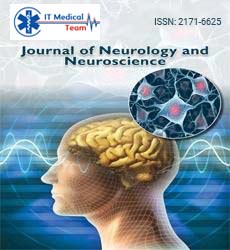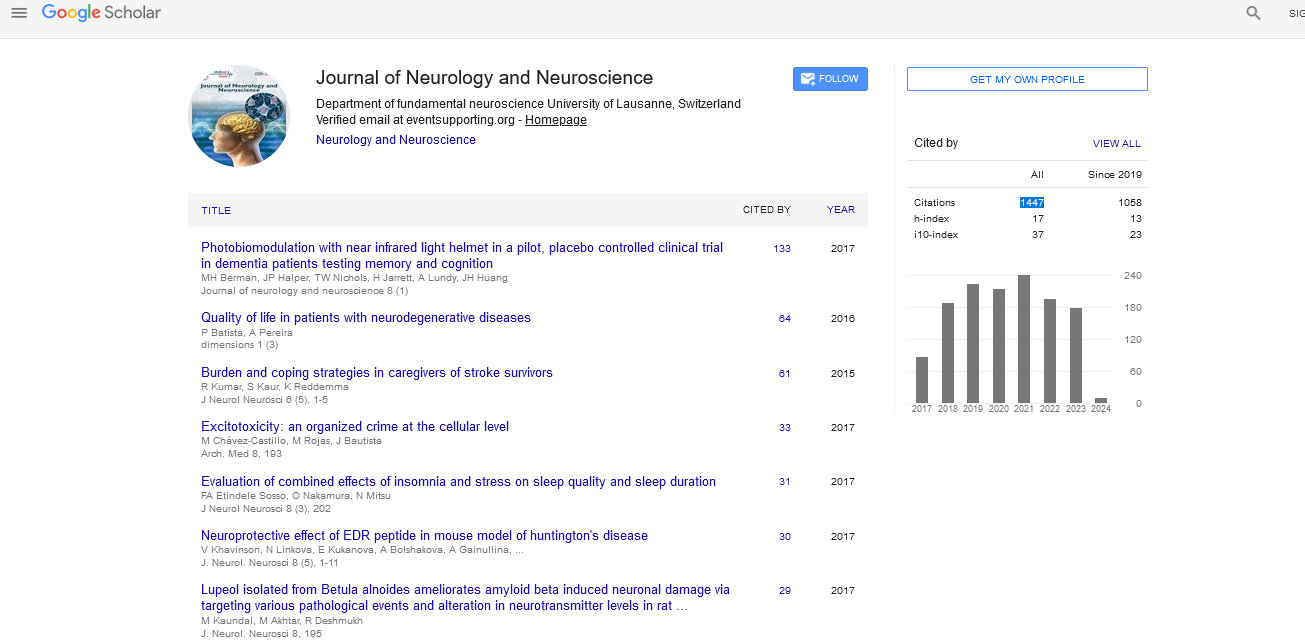Gonca Bektas*, Edibe Pembegul Yildiz, Burak Tatli, Nur Aydinli, Mine Caliskan and Meral Ozmen
Department of Pediatric Neurology, Faculty of Medicine, Istanbul University, Istanbul, Turkey
Corresponding Author:
Gonca Bektas
Department of Pediatric Neurology Faculty of Medicine, Istanbul University, Istanbul, 34093, Turkey
Tel: +902124142000/ 31872
E-mail: goncabektas@gmail.com
Received date: Apr 27, 2016; Accepted date: May 23, 2016; Published date: May 25, 2016
Background: Guillain-Barre syndrome (GBS) is an acute immune-mediated demyelinating polyneuropathy, and it has been suggested that immune-mediated mechanism underlying the pathogenesis of GBS was triggered by infectious agents, vaccination, head trauma, operation, and malignancy. Risperidone, one of the secondgeneration antipsychotic drugs, tends to alter cytokine levels that could partly be attributed to GBS occurrence.
Findings: We herein present a 7 year-old-girl who developed GBS under risperidone treatment. The possibility of occurrence of GBS triggered by risperidone was analyzed using causality assessment scales of Naranjo and World Health Organization Collaborating Centre for International Drug Monitoring, the Uppsala Monitoring Centre (WHO–UMC). The results indicated that risperidone was a probable cause of GBS.
Conclusion: Patients with newly-emerging neurologic symptoms under risperidone should undergo detailed neurologic examination, and if necessary neurophysiologic assessment.
Keywords
Guillain-Barre syndrome; Naranjo; Risperidone; TNF- α
Introduction
Second-generation antipsychotics which lead to fewer adverse effects compared to first-generation antipsychotics are progressively prescribed in pediatric population. Risperidone, one of the second-generation antipsychotic drugs, has been used in attention-deficit/hyperactivity disorder (ADHD), behavioral problems associated with autistic disorder, in addition to psychotic disorders [1]. Although second-generation antipsychotic drugs have a more safety profile than first-generation drugs, adverse drug reactions which are usually related with treatment time and higher dose of risperidone have been increasingly reported in line with expanding clinical use [2]. Studies evaluated the effect of risperidone on cytokine levels pointed that cytokines which are the major component of humoral immunity fluctuate during risperidone treatment. GBS, an immune-mediated demyelinating disorder, may trigger by an agent as risperidone that modifies immune system. We herein present the probable relationship between risperidone and GBS.
Case Report
A 7 year-old girl with an acute onset blurred vision, paresthesias of the distal upper limbs, and speech-rate slowing was referred our pediatric neurology clinic. Her prenatal and family histories were unremarkable, and her developmental milestones were normal. She had been diagnosed with ADHD and treated with risperidone (0.5 mg, twice a day) for two weeks. Two days after the onset of neurological symptoms, she developed diplopia and ataxic gait. On admission, she was consciousness and co-operative. She had left abducens nerve palsy. Power was grade five in upper and lower limbs. Deep tendon reflexes were absent in lower limbs and were decreased in upper limbs. Bladder, bowel functions were normal with no autonomic dysfunction. Deep and superficial sensations were pure. Cerebrospinal fluid routing revealed 46 mg/dL of protein, 86 mg/dL of glucose, 5 lymphocytes/mm3 of cell count. Hemoculture, urine culture, stool culture, serological markers for HIV, hepatitis A and B, Mycoplasma pneumoniae, EBV and CMV were negative. A contrastenhanced craniospinal magnetic resonance imaging which was performed at the third day of symptom onset was unremarkable. A nerve conduction study revealed sensory and motor conduction block, prolonged distal motor and F-wave latencies, abnormal temporal dispersion of motor responses and reductions in maximum motor conduction velocity on the fifth day of symptom onset. We diagnosed GBS based on clinical and electrophysiological findings. Risperidone was discontinued, and intravenous immunoglobulin (IVIG) administered for five consecutive days (0.4 g/kg/day). Ataxic gait and left abducens nerve palsy improved from the third day of IVIG. A repeat neurophysiological study revealed experienced multi-segmental demyelinating polyneuropathy on the fifth week. Six weeks later, upper and lower deep tendon reflexes and neurologic examination were normal. She is in follow-up for 2 years without symptom and her parents gave consent to report her medical records.
Discussion
GBS, an acute inflammatory polyneuropathy, is characterized by immune-mediated demyelination of peripheral nerves. Immune-mediated demyelination which can trigger by several factors as infection, head trauma, operation, and malignancy has been emerged by T cell-mediated autoimmunity or aberrant humoral immunity [3-5].
Recent studies reported that antipsychotic drugs modulate the immune system by alterations in pro-inflammatory cytokine levels, and these alterations show temporal differences according to exposure time to antipsychotic drug [6]. Although risperidone leads to fluctuation of cytokine levels as observed in interleukin-1β and interleukin-6 levels, it was reported that tumor necrosis factor-alpha (TNF-α) which has been recognized as a major mediator in the pathogenesis of GBS increased during risperidone treatment [7,8]. In vivo models revealed that TNF-α is able to induce neuronal demyelination and axonal degeneration [9]. Clinically severity of GBS has also been linked to serum level of TNF- α which has been decreased following treatment with IVIG or plazma exchange [10]. Therefore, an increased level of TNF-α due to risperidone may trigger immune cascade involved in the pathogenesis of GBS. Albeit increased clinic use of risperidone, occurrence of GBS related to risperidone has not been identified yet. This may be related to several polymorphism of TNF-α promoter which is responsible for genetic susceptibility of GBS [11].
On the other hand, we applied causality assessment scales to establish a casual relationship between risperidone and GBS. Score of Naranjo adverse drug reaction probability scale and WHO–UMC system for causality assessment indicated a probable relationship between risperidone and GBS (Table 1). We did not re-challenge with risperidone owing to ethical concerns to clarify causality between GBS and risperidone.
| Questions |
Yes |
No |
Don’t know |
Score |
| Are there previous conclusion reports on this reaction? |
1 |
0 |
0 |
0 |
| Did the adverse event appear after the suspect drug was administered? |
2 |
-1 |
0 |
2 |
| Did the AR improve when the drug was discontinued or a specific antagonist was administered? |
1 |
0 |
0 |
1 |
| Did the AR reappear when drug was re-administered? |
2 |
-1 |
0 |
0 |
| Are there alternate causes [other than the drug] that could solely have caused the reaction? |
-1 |
2 |
0 |
2 |
| Did the reaction reappear when a placebo was given? |
-1 |
1 |
0 |
1 |
| Was the drug detected in the blood [or other fluids] in a concentration known to be toxic? |
1 |
0 |
0 |
0 |
| Was the reaction more severe when the dose was increased or less severe when the dose was decreased? |
1 |
0 |
0 |
0 |
| Did the patient have a similar reaction to the same or similar drugs in any previous exposure? |
1 |
0 |
0 |
0 |
| Was the adverse event confirmed by objective evidence? |
1 |
0 |
0 |
1 |
Table 1: Naranjo adverse drug reaction probability scale, score is 7 which indicates ‘probable’ causality between risperidone and GBS.
In conclusion, risperidone may induce immunological pathway that causes GBS with an unclear mechanism. Given this possibility, neurological symptoms newly-emerged in patients treated with risperidone should be evaluated for occurrence of GBS. However, further evaluations are needed to prove this hypothesis.
9461
References
- Fung LK, Mahajan R, Nozzolillo A, Bernal P, Krasner A, et al. (2016) Pharmacologic treatment of severe irritability and problem behaviors in autism: A systematic review and meta-analysis. Pediatrics Suppl 2: S124-135.
- Menard ML, Thümmler S, Auby P, Askenazy F (2014) Preliminary and ongoing French multicenter prospective naturalistic study of adverse events of antipsychotic treatment in naive children and adolescents. Child Adolesc Psychiatry Ment Health 8: 18.
- Guillian-Barrésyndrome study group (2000) Guillain- Barré syndrome: an Italian multicentre case-control study. NeurolSci 21: 229-234.
- Foubert SA, Penchet G, Yekhlef F, Lemasson G, Sibon I (2005) Guillain-Barré syndrome secondary to cranial surgery: direct or fortuitous relationship? Neurochirurgie 51: 604-606.
- Hughes CL, Yorio JT, Kovitz C, Oki Y (2014) Treatment decisions in a man with Hodgkin lymphoma and Guillian-Barré syndrome: a case report. J Med Case Rep 8: 455.
- Baumeister D, Ciufolini S, Mondelli V (2016) Effects of psychotropic drugs on inflammation: consequence or mediator of therapeutic effects in psychiatric treatment? Psychopharmacology (Berl) 233: 1575-1589.
- Song X, Fan X, Li X, Zhang W, Gao J, et al. (2014) Changes in pro-inflammatory cytokines and body weight during 6-month risperidone treatment in drug naïve, first-episode schizophrenia. Psychopharmacology (Berl) 231: 319-325.
- Stubgen JP (2008) Tumor necrosis factor-alpha antagonists and neuropathy. Muscle and Nerve 37: 281–292.
- Redford EJ, Hall SM, Smith KJ (1995) Vascular changes and demyelination induced by the intraneural injection of tumour necrosis factor. Brain 118: 869–878.
- Deng H, Yang X, Jin T, Wu J, Hu LS, et al. (2008) The role of IL-12 and TNF-alpha in AIDP and AMAN. Eur J Neurol 15: 1100–1105.
- Wu LY, Zhou Y, Qin C, Hu BL (2012) The effect of TNF-alpha, FcgammaR and CD1 polymorphisms on Guillain–Barré syndrome risk: evidences from a meta-analysis. J Neuroimmunol 243: 18–24.





